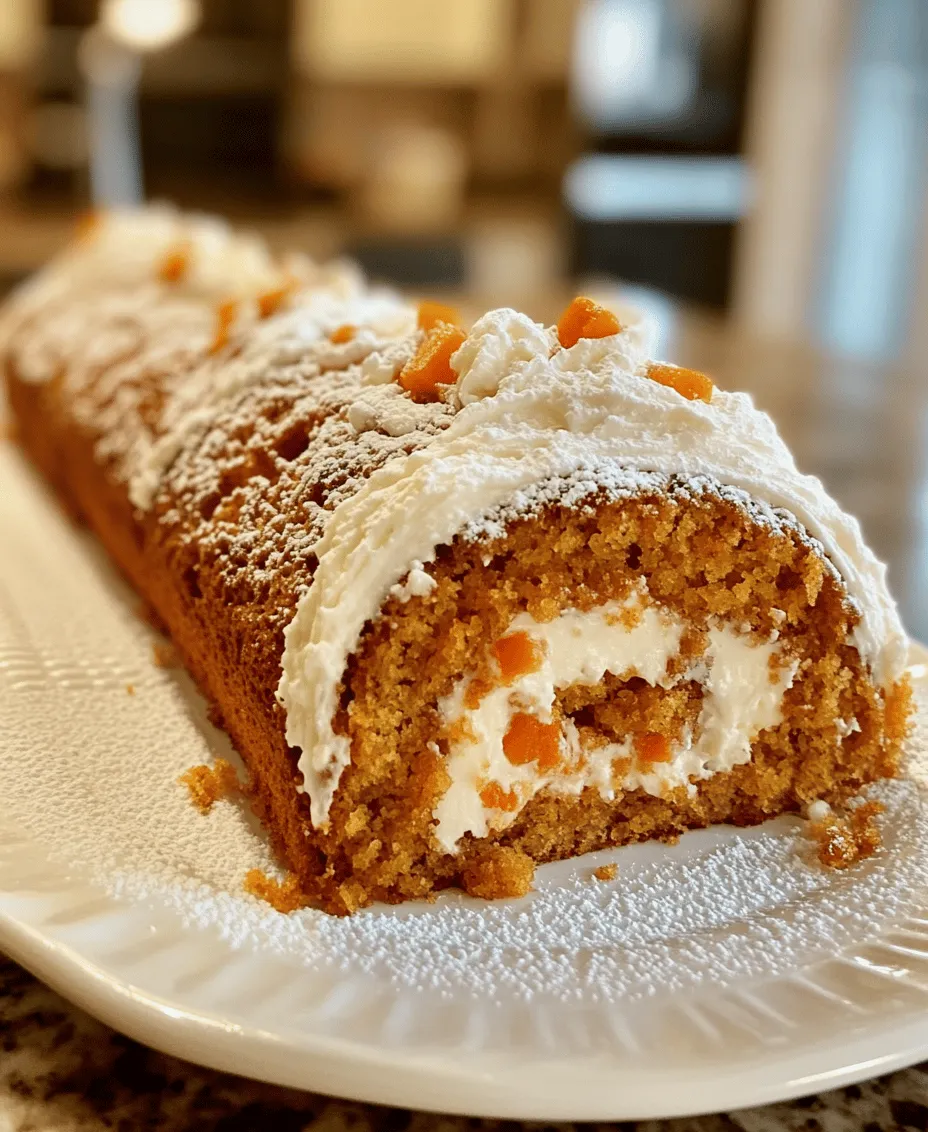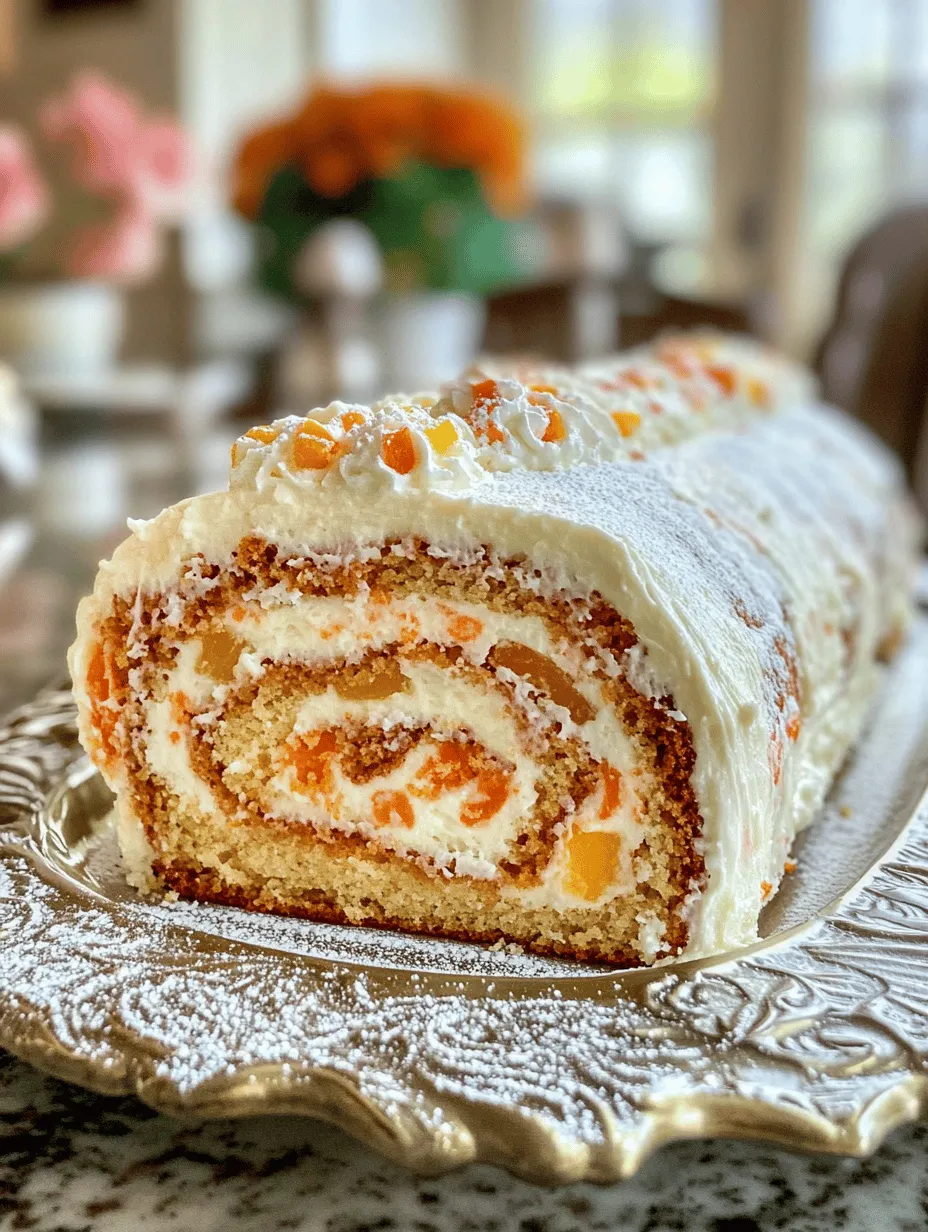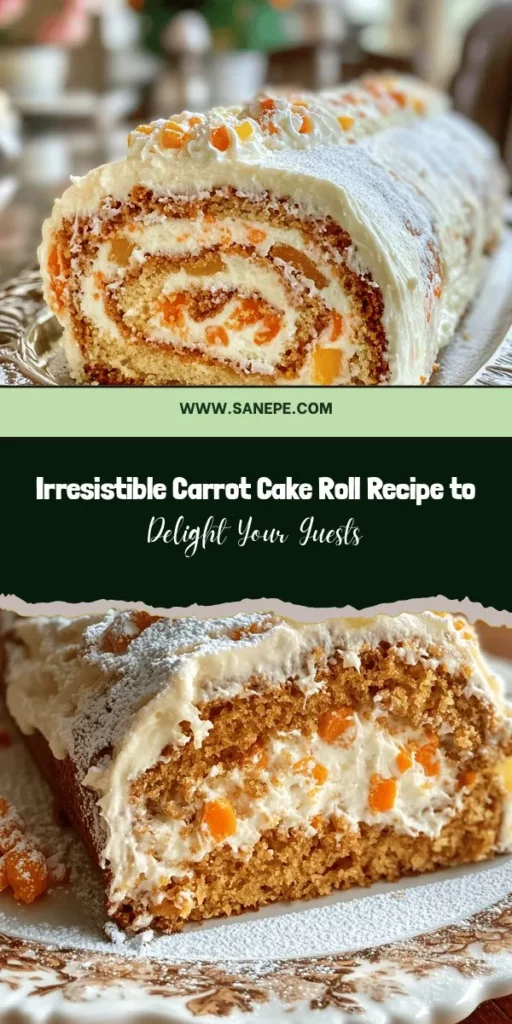Introduction
Carrot cake has long been a beloved dessert, cherished for its moist texture and rich flavor profile. Its popularity can be attributed not only to the delightful taste but also to the hearty, wholesome ingredients that often accompany it, such as spices, nuts, and of course, freshly grated carrots. This classic dessert has evolved over the years, inspiring countless variations and creative interpretations. Among these is the delightful carrot cake roll, a unique twist on the traditional cake that combines the beloved flavors of carrot cake with a visually appealing presentation.
The carrot cake roll is not just a feast for the taste buds; it is also a showstopper when it comes to presentation. Imagine a soft, moist cake rolled around a creamy filling, elegantly sliced to reveal its beautiful spiral. This dessert is perfect for festive occasions, celebrations, or simply to indulge yourself on a cozy afternoon. The combination of spices, the natural sweetness of carrots, and the creaminess of the filling make this carrot cake roll an irresistible treat that is sure to impress your family and friends.
In this article, we will delve into the intricacies of creating your very own carrot cake roll, starting from the essential ingredients to the method of preparation. As we explore the steps involved, you will discover how to achieve that perfect balance of flavors and textures that makes this cake so delightful.
Understanding the Ingredients
Before diving into the preparation of the carrot cake roll, let’s take a closer look at the essential ingredients that contribute to its deliciousness. The quality of the ingredients plays a crucial role in the final outcome of your cake, so it’s important to choose fresh, high-quality items.
Key Ingredients
1. Carrots: The star ingredient of this recipe, fresh carrots provide natural sweetness, moisture, and a vibrant color to the cake. They are best when freshly grated, as this enhances their flavor and texture.
2. Flour: All-purpose flour acts as the structural backbone of the cake. It’s important to measure it accurately to ensure the right texture.
3. Sugar: Granulated sugar sweetens the cake and helps create a moist crumb. Some recipes may also call for brown sugar, which adds a depth of flavor.
4. Eggs: Eggs are essential for binding the ingredients together and providing moisture. Beating them properly will incorporate air into the batter, resulting in a light and fluffy cake.
5. Baking Powder and Baking Soda: These leavening agents help the cake rise, creating a light texture. They also contribute to the cake’s flavor development during baking.
6. Spices: A blend of cinnamon, nutmeg, and ginger adds warmth and depth to the flavor profile, complementing the sweetness of the carrots.
7. Crushed Pineapple: This optional ingredient adds extra moisture and a subtle tropical flavor, enhancing the overall taste of the cake.
8. Walnuts: Chopped walnuts provide a delightful crunch and rich flavor. They are also a great source of healthy fats.
9. Cream Cheese: For the filling, cream cheese adds a tangy richness that perfectly balances the sweetness of the cake.
Nutritional Benefits
Carrots are not just a tasty ingredient; they are also packed with nutrients. Rich in beta-carotene, fiber, and vitamins A, C, and K, carrots contribute to overall health and wellness. The walnuts in this recipe provide heart-healthy fats, protein, and antioxidants, making this cake a more nutritious option compared to many other desserts. By using wholesome ingredients, you can feel good about indulging in this delightful treat.
Preparing the Carrot Cake
Now that we understand the significance of each ingredient, it’s time to prepare the carrot cake roll. Follow these detailed steps to ensure your cake turns out perfectly.
Step 1: Prepping the Oven and Pan
Start by preheating your oven to 350°F (175°C). This ensures that your cake bakes evenly and rises properly. While the oven is heating, prepare your baking pan. For the carrot cake roll, you will need a 15×10-inch jelly roll pan. Line it with parchment paper, allowing some overhang on the sides for easy removal later. Greasing the pan lightly will also help prevent sticking.
Step 2: Mixing the Dry Ingredients
In a medium bowl, sift together the all-purpose flour, baking powder, baking soda, salt, and spices (cinnamon, nutmeg, and ginger). Sifting helps to aerate the flour and ensures that the dry ingredients are evenly distributed. This step is crucial for achieving a light and fluffy cake.
Step 3: Preparing the Wet Ingredients
In a large mixing bowl, beat the eggs until they are light and frothy. This can be done using a hand mixer or a stand mixer. The key is to incorporate air into the eggs, which will help the cake rise. Add the granulated sugar and continue to beat until the mixture is thick and pale. This step is essential for the overall texture of the cake.
Next, gently fold in the grated carrots, crushed pineapple (if using), and chopped walnuts. Make sure these ingredients are evenly distributed throughout the mixture, as they will contribute to the cake’s moisture and flavor.
Step 4: Combining the Mixtures
Gradually add the dry ingredient mixture to the wet ingredients, folding gently with a spatula or wooden spoon. It’s important not to overmix the batter, as this can lead to a dense cake. Fold until just combined, making sure there are no visible flour streaks.
Step 5: Baking the Carrot Cake
Pour the batter into the prepared jelly roll pan, spreading it evenly with a spatula. Bake in the preheated oven for about 15-20 minutes, or until a toothpick inserted in the center comes out clean. Keep an eye on the cake to avoid overbaking, which can dry it out.
While the cake is baking, prepare a clean kitchen towel. Dust it with powdered sugar to prevent sticking when rolling the cake later.
Step 6: Cooling the Cake
Once baked, remove the cake from the oven and let it cool in the pan for about 5 minutes. Carefully invert the cake onto the prepared kitchen towel, removing the parchment paper. Gently roll the cake up in the towel, starting from one of the shorter ends. This step is vital for shaping the roll and ensuring it retains its form as it cools.
Leave the rolled cake to cool completely on a wire rack. This cooling step is crucial, as it allows the cake to set and makes it easier to fill and slice later.
Incorporating Flavorful Additions
As the cake cools, let’s explore the flavorful additions that elevate the carrot cake roll to new heights. Adding crushed pineapple and walnuts not only enhances the moisture and texture of the cake but also brings additional flavors that complement the sweetness of the carrots.
Benefits of Crushed Pineapple and Walnuts
Crushed pineapple adds a subtle sweetness and extra moisture, which helps keep the cake tender. The natural sugars in the pineapple caramelize slightly during baking, contributing a delightful flavor profile. If you’re looking for a more tropical twist, consider using coconut instead of pineapple for a different spin on the classic recipe.
Walnuts, on the other hand, provide a delightful crunch and a rich, nutty flavor that pairs beautifully with the spiced cake. They also add a healthful element, packed with omega-3 fatty acids and antioxidants. If you have nut allergies or prefer a nut-free version, feel free to omit the walnuts or substitute them with sunflower seeds for a similar crunch without the allergens.
Optional Variations and Substitutions
When it comes to baking, creativity knows no bounds. You can customize your carrot cake roll to suit your dietary preferences or explore new flavor combinations. For instance, consider adding raisins or cranberries for an extra layer of sweetness and texture. If you prefer a vegan option, swap out the eggs for flaxseed meal or applesauce, and use a dairy-free cream cheese alternative for the filling.
Baking the Carrot Cake
To ensure your carrot cake roll comes out perfectly, pay close attention to the baking time and temperature. Baking at the right temperature is crucial for achieving that fluffy, moist texture we all love in carrot cake.
Importance of Correct Baking Time and Temperature
Overbaking can lead to a dry cake, while underbaking may result in a gooey center. The ideal baking time for a carrot cake roll is typically between 15-20 minutes. Since ovens can vary, it’s always a good idea to start checking for doneness at the lower end of the baking time. Insert a toothpick or cake tester into the center of the cake; if it comes out clean or with a few moist crumbs, your cake is ready.
Once baked, remember to cool the cake properly before proceeding to the filling stage. Patience during this cooling period will ensure a successful roll that holds its shape and flavor beautifully.
As we delve deeper into the process, the next parts of this article will guide you through creating the luscious cream cheese filling, assembling the carrot cake roll, and providing tips for decoration and serving. Get ready to impress your guests with this delightful dessert that is sure to become a favorite in your home!

Tips for Checking Doneness with a Toothpick
When baking your carrot cake roll, ensuring it is perfectly done is crucial for the best texture and flavor. To check for doneness, use a toothpick or a thin skewer. Insert it into the center of the cake; if it comes out clean or with a few crumbs attached, your cake is ready. If the toothpick has wet batter on it, continue baking for an additional 2-3 minutes before checking again. This method not only helps prevent overbaking but also ensures that your cake remains moist and flavorful.
The Significance of Cooling the Cake in a Rolled Form
Cooling the cake correctly is essential for maintaining its shape and preventing cracks. Once you take the carrot cake out of the oven, immediately turn it onto a clean kitchen towel that has been lightly dusted with powdered sugar. Gently peel away the parchment paper, then roll the cake up in the towel, starting at one end. This technique helps the cake hold its rolled shape as it cools. Allow it to cool completely in this rolled form; this step is vital as it prevents the cake from breaking apart when you unroll it later for frosting.
Crafting the Cream Cheese Frosting
Cream cheese frosting is a classic complement to carrot cake, bringing a rich, tangy flavor that balances the sweetness of the cake. To make the perfect cream cheese frosting, you will need:
– 8 oz cream cheese, softened
– 4 oz unsalted butter, softened
– 4 cups powdered sugar, sifted
– 1 tsp vanilla extract
– A pinch of salt
Detailed Instructions for Achieving the Perfect Frosting Consistency
1. Beat the Cream Cheese and Butter: In a large mixing bowl, combine the softened cream cheese and butter. Using an electric mixer, beat on medium speed until the mixture is smooth and creamy, about 2-3 minutes.
2. Add the Powdered Sugar: Gradually add the sifted powdered sugar, one cup at a time, mixing on low speed to avoid a sugar cloud. Once incorporated, increase the speed to medium and beat until the frosting is fluffy.
3. Flavoring Options: For a delightful twist, consider adding lemon zest or a splash of fresh lemon juice to the frosting. This addition not only enhances the flavor but also complements the spices in the carrot cake beautifully. Other options include a teaspoon of cinnamon for extra warmth or even a hint of maple syrup for a lovely depth.
Assembling the Carrot Cake Roll
Now that your cake is cool and your frosting is prepared, it’s time to assemble your delicious carrot cake roll.
Step-by-Step Guide for Unrolling, Frosting, and Re-Rolling the Cake
1. Unroll the Cake: Carefully unroll the cooled cake from the towel. Gently peel away the towel, being cautious not to tear the cake.
2. Frosting the Cake: Using an offset spatula, spread an even layer of cream cheese frosting over the surface of the cake, leaving about a half-inch border around the edges.
3. Re-Roll the Cake: Starting from one of the short ends, roll the cake back up tightly, ensuring the frosting stays intact. As you roll, apply gentle pressure to avoid any cracks.
4. Visual Cues for Even Frosting: Make sure to keep the frosting layer even across the entire surface for a beautiful final appearance. If the frosting starts to slide, you can secure it with a toothpick until the roll sets.
5. The Role of the Kitchen Towel: The kitchen towel not only assists in shaping the roll but also helps absorb excess moisture, which is key to achieving a stable structure.
Chilling and Serving the Cake
Once your carrot cake roll is assembled, chilling it before serving enhances its flavors and helps the frosting firm up.
Benefits of Chilling the Cake Before Serving
Chilling the cake for at least 30 minutes (or longer if possible) allows the frosting to set and makes slicing much easier. This step also melds the flavors together, creating a deliciously cohesive taste experience.
Presentation Tips to Enhance Visual Appeal
For a beautiful presentation, dust the chilled carrot cake roll with powdered sugar just before serving. You can also garnish with chopped nuts or a sprinkle of cinnamon for an added touch of elegance.
Suggestions for Serving Sizes and Pairing Ideas
When it comes to serving, slice the cake roll into approximately 1-inch pieces. This size allows guests to enjoy a taste without overwhelming their palate. The carrot cake roll pairs wonderfully with a warm cup of tea or coffee, making it a delightful addition to afternoon gatherings or dessert tables.
Storing Leftovers
If you find yourself with leftover carrot cake roll, proper storage is key to maintaining its freshness.
Best Practices for Storing the Carrot Cake Roll
Wrap the cake tightly in plastic wrap or place it in an airtight container. This will help prevent it from drying out in the fridge. Properly stored, the cake should last up to a week in the refrigerator.
Tips on Freezing Portions for Later Enjoyment
For longer storage, you can freeze portions of the carrot cake roll. Slice the roll into individual servings and wrap each slice tightly in plastic wrap before placing them in a freezer-safe container. The cake can be frozen for up to three months. When you’re ready to enjoy, simply thaw in the fridge overnight.
Discussion of Shelf Life and How to Recognize Spoilage
To determine if your cake has gone bad, check for any off smells, mold, or noticeable changes in texture. If the frosting loses its flavor or the cake becomes excessively dry, it’s best to discard it.
Conclusion
The delightful flavors and textures of the carrot cake roll are bound to impress anyone who tries it. From the moist, spiced cake to the creamy, tangy frosting, this dessert is a perfect balance of sweet and savory. Its versatility makes it suitable for various occasions, be it a birthday celebration, holiday feast, or a simple afternoon tea.
We encourage you to try making this carrot cake roll for a unique dessert experience. With its beautiful presentation and delicious taste, it’s sure to become a favorite in your baking repertoire. So gather your ingredients, roll up your sleeves, and enjoy this scrumptious treat that’s bound to leave your guests asking for seconds!


